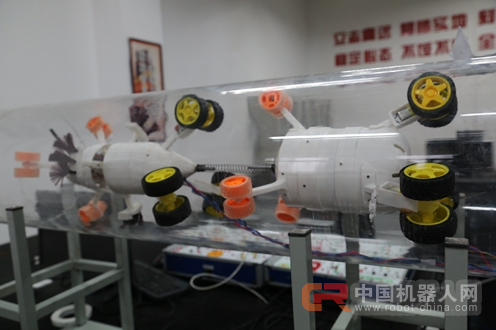
In this way, in the step-by-step practice, Eddie and the team members gradually changed from a “nest outsider” to a “robot fan”. Daily discussion with teammates of design ideas and design options, analysis and summary, debugging of the robot to solve some problems in the operation process. Due to tight deadlines and large project tasks, in the summer of 2016, Eddie and team members chose to stay in school to continue their work in order to be able to better communicate and collaborate. A group of young men stayed in the lab and learned from scratch. They followed the teacher to learn mechanical CAD specifications and mechanical drawings. Prof. Zhou Ding also took over from Hankou for more than two hours to guide them. “Draw your own picture, and then repeatedly modify the plan according to the requirements of the teacher and Professor Zhou, until you are satisfied. From the experiment to the practice, the team owner will continue to be more understanding and team cohesion will become stronger.”7 At the beginning of the month, continuous heavy rains in Wuhan caused many roads to be submerged. In those days, the entire team members were eating and drinking all in the laboratory, working overtime, and sleeping at night with 50-60 stools. They were their beds. ". Recalling the hardships of the project at the time, Eddy said he had learned a lot and had grown a lot. One side of the design, reference, from 3D modeling, to 3D printing, in the course of a step-by-step practice, the combat effectiveness of the entire team is also becoming stronger. In November, in the 8th national university information technology innovation and practice event held in Jiangnan University, the “Pipeline Cleaning Robot” of the Eddy team won the first prize in the national finals. Previously, this work also won the first prize in the Hubei Division. “They got the national first prize and two invention patents. I think it is a matter of course,” said Professor Zhou Ding, an ad hoc technical consultant. This 70-year-old man was called "China's first person to develop a small roller" and owned 53 patents from the country. He basically achieved results transformation and received 10 provincial and ministerial-level scientific and technological progress awards. Currently, he is the school's electrical and mechanical department. Robotics academic leaders. Professor Zhou Ding said that the current product is still in its infancy. To really become a product, it takes a long way to go into business. “Our end product is to be put on the market, and the duct vacuum cleaner is also aimed at the foreign advanced level.” Professor Zhou is full of confidence for the entire team and project. Although the product continues to be researched, the result of the "Pipeline Cleaning Robot" has been obtained as a "Ultimate Wind Cleaner" utility model patent certificate (Certificate No.: ZL 2015.20783306.9), "An indoor air duct cleaning The "Robot" invention patent certificate has been approved and will be sent to the student team next month. Many companies have also expressed their intention to cooperate and expect to cooperate with the team.
Yuhai piezo materials include : hard piezo material, soft piezo material and lead free piezo material
Soft piezo material exhibits: larger piezoelectric constants, higher permittivity, larger dielectric constants, higher dielectric losses, larger electromechanical coupling factors, low mechanical quality factors, a lower coercive field, poor linearity, and is easier to depolarize. The ideal application of soft piezo materials is sensing needs. Yuhai soft pizeo materials are PZT-5, PZT-5H, PSnN-5 and PLiS-51.
Hard piezo material exhibits: smaller piezoelectric constants, lower permittivity, smaller dielectric constants, lower dielectric losses, smaller electromechanical coupling factors, high mechanical quality factors, a higher coercive field, better linearity, and is harder to depolarize. The ideal application of hard piezo materials is high power transducer needs. Yuhai hard pizeo materials are PZT-4, PZT-8, PCrN-4 and PBaS-4.
Yuhai company developped lead free piezo material BaTiO3 and apply for the Chinese Patent in 2011, to meet the needs of environmental protection in today's society.
Piezoelectric Ceramic material Properties and Classification General description of material properties Material Code Properties Application Soft PZT ceramic PZT-51 Characteristics: larger piezoelectric constants, higher permittivity, larger dielectric constants, higher dielectric losses, larger electromechanical coupling factors, low mechanical quality factors, a lower coercive field, poor linearity, and is easier to depolarize. low-power ultrasonic transducers PZT-52 low-frequency sound transducers PZT-53 applications with high g coefficient, for example, PZT-5H microphones,vibration pickups with preamplifier PLiS-51 low-frequency vibration measurements PMgN-51 Hydrophones, transducers in medical diagnostics PSnN-5 Actuators Hard PZT ceramic PZT-41 Characteristics: smaller piezoelectric constants, lower permittivity, smaller dielectric constants, lower dielectric losses, smaller electromechanical coupling factors, high mechanical quality factors, a higher coercive field, better linearity, and is harder to depolarize. PZT-42 High-power acoustic applications PZT-43 Hydroacoustics, sonar technology PZT-82 piezomotor PCrN-4 PBaS-4 Lead free Piezo Ceramic BaTiO3 Characteristics: Low density, low curie temperature, lead free. Ultrasonic transducers suitable for low-temperature underwater, for example Ultrasonic Transducer in fishfinder
Piezoelectric Material,Piezo Ceramic Element,Piezo Electric Cylinder ,Piezo Sphere
Zibo Yuhai Electronic Ceramic Co., Ltd. , https://www.yhpiezo.com
没有评论:
发表评论